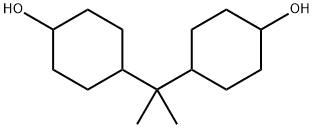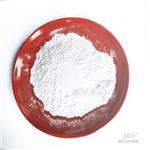Description
2,2-Bis(4-hydroxycyclohexyl)propane, also known as 4,4'-Isopropylidenedicyclohexanol, is a crystalline, colorless, and odorless compound. The conformation of the cyclohexane rings gives rise to cis-cis, cis-trans and trans-trans isomers. The industrial product is a mixture of these stereoisomers. The physical properties depend on the relative amounts of the isomers present. The trans-trans compound has the lowest energy and is formed from the other isomers at higher temperature. It has the lowest solubility in solvents such as methanol, butanol, and acetone and has the highest melting point of these isomers.
Uses
4,4'-isopropylidenedicyclohexanol is unsaturated polyester resin, epoxy resin raw materials, especially as glass, steel, artificial marble bathtub, plating tank and other components, and has a water resistance, chemical resistance, thermal stability and light stability.
Production Methods
4,4'-Isopropylidenedicyclohexanol is produced by hydrogenation of bisphenol A, 2,2-bis(4-hydroxyphenyl)propane, an industrially important compound made from acetone and phenol (Phenol Derivatives). Bisphenol A is hydrogenated at about 10-30 MPa and at 150-250 ℃ on a nickel, cobalt, or ruthenium catalyst.
Flammability and Explosibility
Non flammable
Structure and conformation
4,4' -Isopropylidenedicyclohexanol (HBPA), hydrogenated from bisphenol A (BPA), is a promising and revealing alicyclic candidate to offer diamine or dianhydride monomers. Due to the different spatial conformations of hydroxyls, HBPA has three isomers, including H' BPA, H''BPA, and H'''BPA, and their contents are 47%, 45%, and 8%, respectively. However, few reports about nonplanar HBPA-based polyimides were found, probably because of the difficulty separating HBPA isomers[1-2].

References
[1] Z. Hou. “Soluble copolyimides containing 4,4′-isopropylidenedicyclohexanol (HBPA) isomer units: Synthesis, characterization, thermal, mechanical, and optical properties.” High Performance Polymers 32 1 (2019): 406–417.
[2] Zhiming Mi. “Transparent and soluble polyimide films containing 4,4′-isopropylidenedicyclohexanol (Cis-HBPA) units: Preparation, characterization, thermal, mechanical, and dielectric properties.” Journal of Polymer Science Part A: Polymer Chemistry 56 18 (2018): 2115–2128.





